Raising Rabbits in Hawaii
L. Rieber No Spray Staff WriterRaising rabbits is easy! When raised properly, rabbits are great additions to any home and garden! They eat the excess from the garden, they never need to be walked and they make very little noise. Best of all they provide you with an all natural, free fertilizer for your garden saving you hundreds of dollars.
Don’t have time to gather the rabbit manure everyday?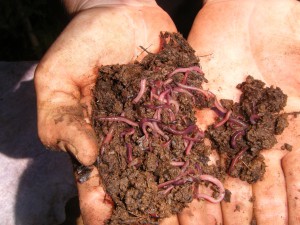
No worries! I have developed an older system that works with very little upkeep and no gathering of manure!! Best of all this system minimizes flies and pest, reduces all nasty smells and makes it easy to collect the nutrient rich manure, when you are ready for it!!
How?
Earthworms!! The natural gardeners’ best friend! If you have these little guys in the garden, you know you have one healthy ecosystem under the surface. When raised under rabbit cages, they happily will convert your rabbits’ droppings into a even more nutrient rich casting, also known as “black gold”!
Interested yet?
Rabbits and earthworms have been raised together for hundreds of years. Before the world wars, almost all American households had gardens and they raised rabbits, chickens and ducks for the manure needed to keep everything healthy. People a hundred years ago did not rely on store bought products to grow food, they relied on nature and natures principles, just like a native forest does.
Rabbits and earthworms raised together provide the other with their perfect 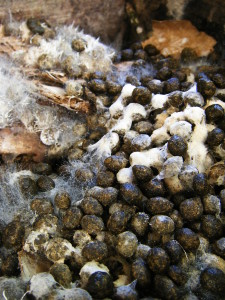 environment for survival. Let’s think about it for a moment. Rabbits love greens, grasses and forage. They love a garden vegetable here and there too, but this is not its daily diet. Rabbit manure is considered “cold” and does not immediately harm the earthworms like chicken and horse manure does when fresh.
environment for survival. Let’s think about it for a moment. Rabbits love greens, grasses and forage. They love a garden vegetable here and there too, but this is not its daily diet. Rabbit manure is considered “cold” and does not immediately harm the earthworms like chicken and horse manure does when fresh.
Earthworms love the little bunny pellets because they are covered with microbes, their favorite food! Earthworms will convert the fresh rabbit manure into a crumbly black, nutrient rich soil called castings or black gold. This is the best form of nutrients or fertilizer for your plants. It also helps reduce pests, disease outbreaks and infestations. On top of providing your plants with free nutrients, earthworm castings help your plants survive through droughts and heavy rains!
Amazing Stuff!
You can’t ask for much more. If you have a garden, thinking about starting a garden or need help with a current garden…. bunnies and earthworms are a great start. Providing you with the IMO’s (indigenous micro-organisms)that are needed for healthy plants and fresh nitrogen, having them are a no brainer.
How to get started-
For the rabbit:
You need a cage- rabbits will chew threw wood and other soft materials including PVC and many plastics. With that in mind, you must make your rabbit cage using metal wire or fencing materials. Lots of literature states to use materials with holes 1″ x 1/4″ wide to make sure your rabbits feet don’t get stuck. I agree. This 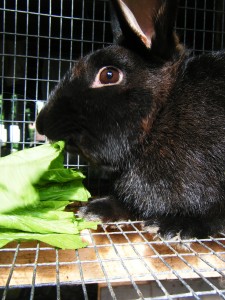 is the perfect size too, for the rabbit manure to drop through the cage when stepped on and not get stuck.
is the perfect size too, for the rabbit manure to drop through the cage when stepped on and not get stuck.
I personally do not recommend a solid bottom, although some literature does. Rabbits raised on the farm have a purpose. They are to supply your garden free, nutrients (fertilizers). They do this by providing the earthworms below their cage food in the form of their manure and the earthworms converts it into free fertilizer. A solid bottom prevents this cycle. A solid cage gathers the feces and urine and stores it, allowing harmful bacteria to grow and your bunnies can get sick. This is where mites, bacterial eye problems and even dirty, urine stained rabbit feet come from. Plus it is a lot more work on your part, and we are minimizing work!
Yes, your rabbit will eat their own feces. Yes, they need the bacteria on their feces to complete their digestion but those feces when they come out, they are thicker then the other pellets. Your rabbit will have the chance to consume it before stepping on it, forcing it through the hole.
The cage should be elevated, enough to fit your worm bin under. An adult male rabbit needs roughly 5 – 6 ft of floor space and an adult female to be bred needs about 7.5 sq ft of floor space. So a good cage would be 2.5 ft by 3 ft wide and 18 – 24 inches high. This gives enough room for your rabbit to jump around (two full hops) stretch up, yet small enough for you to be able to reach your rabbit if needed.
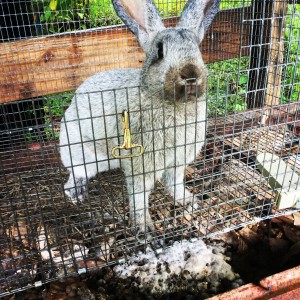 The rabbit cage doesn’t have to be mounted to anything- it can be a metal cage that is set upon the worm bin. This allows the cage to be easily moved if needed and to clean if wanted. You will need to make sure it has a roof and protected from heavy sheets of rain and wind. But depending on placement of the rabbit, you may not have to mount anything.
The rabbit cage doesn’t have to be mounted to anything- it can be a metal cage that is set upon the worm bin. This allows the cage to be easily moved if needed and to clean if wanted. You will need to make sure it has a roof and protected from heavy sheets of rain and wind. But depending on placement of the rabbit, you may not have to mount anything.
For the Earthworm
Earthworms are a great pet. They are even less needy than the rabbit. They just need a carbon rich bed and they are set to go. Well, not that easy, but almost.
Read more about earthworms and microbes HERE.
Construct your earthworm bin using something recyclable, including an old plastic tote bin or even an old wooden box (untreated). Holes and cracks are fine! If your bin doesn’t have holes, you have to put some in the bottom. Best is if you put them 1/4″ up, this guarantees that moisture will always be in the bin, just in case, yet it can never flood or go anaerobic (stinky)!
Once you found your bin, you have to find some bedding. Their bedding should be full of carbon materials. Carbon things are usually brown, dry and dead. Examples include dried leaves, coconut fiber, cardboard, newspaper and even dried hay or grass. Again, use recycled materials, earthworms love this the best. Be careful not to add nitrogen rich material. Nitrogen rich includes materials that are green, fresh or wet like grass clippings, fresh leaves or even kitchen scraps. Earthworms eat the microbes th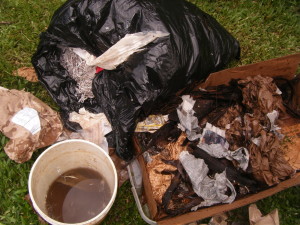 at reside on nitrogen rich materials, but we want our earthworms to eat the nitrogen rich rabbit manure, not kitchen scraps.
at reside on nitrogen rich materials, but we want our earthworms to eat the nitrogen rich rabbit manure, not kitchen scraps.
Your earthworm bin must be kept moist! Earthworm can not drown, but they will dry out!!! Earthworms need moisture for survival, it’s how they breath, move and live. They actually like about a 75% moisture in their surrounding areas, but can handle more. 75% moisture is the same as a wet sponge that you wring out and only a couple drops come out. Prior to filling your bin, soak of all bedding material is a good idea! I put everything in a five gallon bucket of water, let it soak for a few minutes, wring out, then do my layers.
So now you have your bin, your materials and moisture! Your ready to construct your bin!! Earthworms are easy to maintain! Trust me- if they weren’t, we wouldn’t have any. But they are easy, once set up, they take care of themselves.
Constructing your bin!
Besides moisture, your earthworms need oxygen. They breath through their skin, which has to be kept moist but also needs to have space for air. Earthworms will not stay in stagnant water. So to ensure they have oxygen, break up your materials into small chunks. Depending on what you are using, this will all be different. Imagine shredded newspaper, this would be ideal. If you take a look, you will see all the spaces in between the paper. This is all for oxygen! You want to make sure that your bedding doesn’t “cake up” and become solid. The earthworms will not be able to move through nor breath. If you just have paper or cardboard, shred it yourself into smaller pieces.
Now your ready to find a place
Rabbits need a little bit of sunshine, but earthworms prefer to stay cool and in the shade. Ideally find a place that gets at least one, but no more than 3 hours of direct sunshine. This allows the bacteria in the cage to be kept at check by the suns’ rays preventing your bunny from getting sick. Plus all animals need some sunshine! This amount of sun also is not enough to hurt the earthworms in their carbon rich, moist bed for just a few hours.
Find a place that is protected from constant wind or rain as well. Rabbits can survive some weather, but if there is a major storm, you may need to supply them with added protection. Rabbits like the cool weather too and can over heat if the temperature is too high for too long.
We have one of our bunny bins under a large rhombaton tree. This bunny gets the morning sunshine for only a couple of hours and then shade during the heat of the day. We placed an old roofing tin on her cage and that is sufficient enough for the rain and during storms she gets another tin on one side to create a little area for her to snuggle in.
Another set is behind a shed, utilizing the extra roofing that hangs over the walls. This is just the right amount to protect enough of the cage from rain and wind. We have another set on the side of another shed. We used another roofing tin for her too, and works quite well.
Have fun!
=============================================================
About the Author:
 Laura Rieber holds a BS in Agriculture with a focus on sustainability from the University of Hawaii, several certificates in agriculture business development and is a master gardener. The moment she realized the corporate lies that feed the world was the moment she was inspired to write about the truth about natural agriculture. She co-created No Spray Hawaii with her partner, Jesse Fujimoto to help others gain awareness. She teaches natural agriculture principles on the Big Island of Hawaii. CONTACT
Laura Rieber holds a BS in Agriculture with a focus on sustainability from the University of Hawaii, several certificates in agriculture business development and is a master gardener. The moment she realized the corporate lies that feed the world was the moment she was inspired to write about the truth about natural agriculture. She co-created No Spray Hawaii with her partner, Jesse Fujimoto to help others gain awareness. She teaches natural agriculture principles on the Big Island of Hawaii. CONTACT
============================================================
Want to WWOOF in Hawaii at No Spray? CLICK HERE
=============================================================
“No Spray”
Find the other way!

